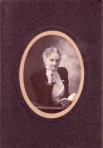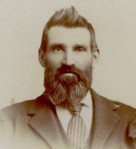If someone had told Ralph and Minerva Flint Sheldon that their son, Andrew, would grow up to become a renowned physician and a personal friend of President Abraham Lincoln, they probably would have scoffed.
In 1830, Andrew was born in the small town of Huron in Wayne County, New York. As one of Ralph and Minerva Flint Sheldon’s five children, Andrew was expected to help them with the farm. However, at some point, Andrew developed an interest in medicine. At the age of 22, he graduated from the University of New York’s Medical Department. He married Miss Lucetta Salsbury in 1857, and they began their married life together in Williamson, New York. They then moved to Junius, New York, where Andrew practiced medicine until he was called upon to put his skills to the test for the Union army during the Civil War.
 Seven months into the War, Dr. Sheldon was commissioned as Assistant Surgeon with the 7th New York Cavalry. In April 1862, he was appointed as Assistant Surgeon with the 78th New York Infantry. By October of 1862, Andrew had been commissioned as an officer in the U.S. Volunteers. President Lincoln himself promoted Dr. Sheldon to Surgeon of the United States Volunteers in charge of Campbell Hospital in Washington, D.C. in April, 1863. It was sometime during these early years of the war that Dr. Andrew Sheldon is credited in the War Department with creating the first field tent hospital. According to the office of the Wayne County Historian, Andrew F. Sheldon financed the first tent hospitals with his own money after having been unable to obtain the funds elsewhere. Tent hospitals are still in existence today throughout the world, and serve as an invaluable tool to obtaining immediate medical treatment before the sick and wounded are transported to conventional hospitals.
Seven months into the War, Dr. Sheldon was commissioned as Assistant Surgeon with the 7th New York Cavalry. In April 1862, he was appointed as Assistant Surgeon with the 78th New York Infantry. By October of 1862, Andrew had been commissioned as an officer in the U.S. Volunteers. President Lincoln himself promoted Dr. Sheldon to Surgeon of the United States Volunteers in charge of Campbell Hospital in Washington, D.C. in April, 1863. It was sometime during these early years of the war that Dr. Andrew Sheldon is credited in the War Department with creating the first field tent hospital. According to the office of the Wayne County Historian, Andrew F. Sheldon financed the first tent hospitals with his own money after having been unable to obtain the funds elsewhere. Tent hospitals are still in existence today throughout the world, and serve as an invaluable tool to obtaining immediate medical treatment before the sick and wounded are transported to conventional hospitals.
On April 14, 1865, just hours before his assassination by John Wilkes Booth, President Lincoln presented Dr. Andrew F. Sheldon with a case of surgical instruments at Campbell Hospital. The case, created by G. Tiemann & Company of New York, was made of mahogany with brass corner straps and lock, and the compartments are lined with blue velvet. Many of the handles on the surgical instruments are of ivory. That case was, for many years after Andrew’s death, in the collection of his son, Ralph Sheldon, M.D. In 1948, it was displayed in the Lyons, New York, drugstore window of Bill Dobbins in commemoration of the 125th anniversary of Wayne County. Dr. Sheldon’s surgical case is now in the possession of the Wayne County Historical Society. President Lincoln and Secretary of State William H. Steward personally contributed toward the gift. On the same date, Dr. Sheldon was presented with an ebony cane mounted with a gold cap and engraved, “Presented to A. F. Sheldon, surgeon U.S.V., by his friends at Campbell Hospital, Washington, D.C. April 14, 1865”.
After the war ended, Andrew resumed his practice. He and Lucetta had six children together, three of whom died in infancy. Daughter Nora Belle married Charles F. Powers and they had two sons, Whitney and Albert. Despite his medical background, Andrew was unable to save the life of his daughter and she died at his home in Lyons at age 35 of gastric catarrh. Son Ralph followed in his father’s footsteps and became a physician. Both father and son practiced medicine for over 50 years. Although Ralph was twice married, he had no children. Younger son, Albert, became a manager of the International Silver Company based out of Lyons, New York. He also served as Lyons Village Trustee. Albert and his wife, Caroline Hersey Sheldon, had one daughter named Mary Elizabeth.
After spending the last 31 years of his life in Lyons, New York, Andrew F. Sheldon died in 1914 at the age of 83. He and his family are buried in Wayne County, New York.
Andrew F. Sheldon spent much of his life as a servant of the people. Besides being a physician, he also spent many years as the Wayne County Treasurer, President of the Soldiers and Sailors Association of Wayne County, and was very active in the G.A.R., a patriotic organization dedicated to aiding veterans of the Civil War. His greatest legacy, however, is as originator of the field tent hospital during the Civil War.
This article was originally published in the ‘Baker-Cederberg Notebook’, Vol. 22, No. 2, Fall-Winter 2010, a semi-annual newsletter published by the Rochester Medical Museum & Archives. To learn more about the Rochester Medical Museum & Archives, please visit their website at http://www.rochestergeneral.org/rochester-general-hospital/about-us/rochester-medical-museum-and-archives/.




